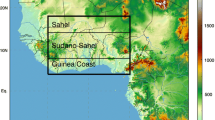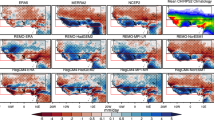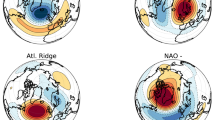Abstract
General circulation models still show deficiencies in simulating the basic features of the West African Monsoon at intraseasonal, seasonal and interannual timescales. It is however, difficult to disentangle the remote versus regional factors that contribute to such deficiencies, and to diagnose their possible consequences for the simulation of the global atmospheric variability. The aim of the present study is to address these questions using the so-called grid point nudging technique, where prognostic atmospheric fields are relaxed either inside or outside the West African Monsoon region toward the ERA40 reanalysis. This regional or quasi-global nudging is tested in ensembles of boreal summer simulations. The impact is evaluated first on the model climatology, then on intraseasonal timescales with an emphasis on North Atlantic/Europe weather regimes, and finally on interannual timescales. Results show that systematic biases in the model climatology over West Africa are mostly of regional origin and have a limited impact outside the domain. A clear impact is found however on the eddy component of the extratropical circulation, in particular over the North Atlantic/European sector. At intraseasonal timescale, the main regional biases also resist to the quasi-global nudging though their magnitude is reduced. Conversely, nudging the model over West Africa exerts a strong impact on the frequency of the two North Atlantic weather regimes that favor the occurrence of heat waves over Europe. Significant impacts are also found at interannual timescale. Not surprisingly, the quasi-global nudging allows the model to capture the variability of large-scale dynamical monsoon indices, but exerts a weaker control on rainfall variability suggesting the additional contribution of regional processes. Conversely, nudging the model toward West Africa suppresses the spurious ENSO teleconnection that is simulated over Europe in the control experiment, thereby emphasizing the relevance of a realistic West African monsoon simulation for seasonal prediction in the extratropics. Further experiments will be devoted to case studies aiming at a better understanding of regional processes governing the monsoon variability and of the possible monsoon teleconnections, especially over Europe.













Similar content being viewed by others
References
Bougeault P (1985) A simple parametrization of the large-scale effects of cumulus convection. Mon Weather Rev 113:2108–2121. doi:10.1175/1520-0493(1985)113<2108:ASPOTL>2.0.CO;2
Cassou C, Terray L, Phillips AS (2005) Tropical Atlantic influence on European heat waves. J Clim 18:2805–2811. doi:10.1175/JCLI3506.1
Cook KH, Vizy EK (2006) Coupled model simulations of the West African monsoon system: twentieth and twenty-first-century simulations. J Clim 19:3681–3703. doi:10.1175/JCLI3814.1
Douville H, Salas-Mélia D, Tyteca S (2006) On the tropical origin of uncertainties in the global land precipitation response to global warming. Clim Dyn 26:367–385. doi:10.1007/s00282-005-0088-2
Fontaine B, Janicot S (1996) Seas surface temperature fields associated with West African rainfall anomaly types. J Clim 9:2935–2940. doi:10.1175/1520-0442(1996)009<2935:SSTFAW>2.0.CO;2
Fontaine B, Janicot S, Moron V (1995) Rainfall anomaly patterns and wind field signals over West Africa in August (1958–1989). J Clim 8:1503–1510. doi:10.1175/1520-0442(1995)008<1503:RAPAWF>2.0.CO;2
Garric G, Douville H, Déqué M (2002) Prospects for improved seasonal predictions of monsoon precipitation over Sahel. Int J Climatol 22(3):331–345. doi:10.1002/joc.736
Hoskins BJ, Ambrizzi T (1993) Rossby wave propagation on a realistic longitudinal varying flow. J Atmos Sci 50:1661–1671. doi:10.1175/1520-0469(1993)050<1661:RWPOAR>2.0.CO;2
Janicot S, Trzaska S, Poccard I (2001) Summer Sahel-ENSO teleconnection and decadal time scale SST variations. Clim Dyn 18:303–320. doi:10.1007/s003820100172
Janicot S, Mounier F, Hall NMJ, Leroux S, Sultan B, Kiladis GN (2009) The dynamics of the West African monsoon. Part IV: Analysis of the 25–90-day variability of convection and the role of the Indian monsoon. J Clim 22:1541–1565
Joly M, Voldoire A, Douville H, Terray P, Royer J-F (2007) African monsoon teleconnections with tropical SSTs: validation and evolution in a set of IPCC4 simulations. Clim Dyn 29:1–20. doi:10.1007/s00382-006-0215-8
Jung T, Palmer T, Rodwell M, Serrar S (2008) Diagnosing forecast error using relaxation experiments. ECMWF Newsletter No. 116:24:34, Summer 2008
Matthews AJ (2004) Intraseasonal variability over tropical Africa during northern summer. J Clim 17:2427–2440. doi:10.1175/1520-0442(2004)017<2427:IVOTAD>2.0.CO;2
Michelangeli P-A, Vautard R, Legras B (1995) Weather regimes: recurrence and quasi stationarity. J Atmos Sci 52:1237–1256. doi:10.1175/1520-0469(1995)052<1237:WRRAQS>2.0.CO;2
Mohino Harris E, Rodríguez-Fonseca B, Gervois S, Janicot S, Losada Doval T, Bader J, Ruti PM, Chauvin F (2008) SST-forced signals on West African rainfall from AGCM simulations—Part I: Intercomparison of models. Clim Dyn (submitted)
Moron V, Philippon N, Fontaine B (2004) Simulation of West African monsoon circulation in four atmospheric general circulation models forced by prescribed sea surface temperature. J Geophys Res 109:D24105. doi:10.1029/2004JD004760
Pohl B, Janicot S, Fontaine B, Marteau R (2009) Implication of the Madden–Julian Oscillation in the 40-day variability of the West African Monsoon. J Clim 22:3769–3785
Raicich F, Pinardi N, Navarra A (2003) Teleconnections between Indian monsoon and Sahel rainfall and the Mediterranean. Int J Clim 23:173–186. doi:10.1002/joc.862
Redelsperger J-L, Thorncroft CD, Diedhiou A, Lebel T, Parker DJ, Polcher J (2006) African Monsoon multidisciplinary analysis. An international research project and field campaign. Bull Am Meteorol Soc 87:1739–1746. doi:10.1175/BAMS-87-12-1739
Rodwell MJ, Hoskins BJ (1996) Monsoons and the dynamics of deserts. QJR Meteorol Soc 122:1385–1404. doi:10.1002/qj.49712253408
Rowell DP (2001) Teleconnections between the tropical Pacific and the Sahel. QJR Meteorol Soc 127:1683–1706. doi:10.1002/qj.49712757512
Ruti PM, Dell’ Aquila A (2008) The 20th century AEJ and AEWs in reanalyses and IPCC simulations. AMMA report
Salas y Mélia D, Chauvin F, Déqué M, Douville H, Guérémy JF, Marquet P, Planton S, Royer J-F, Tyteca S (2005) Description and validation of CNRM-CM3 global coupled climate model, Note de Centre du GMGEC No. 103, Décembre 2005
Sperber KR, Palmer TN (1996) Interannual tropical rainfall variability in general circulation model simulations associated with the Atmospheric Model Intercomparison Project. J Clim 9:2727–2750. doi:10.1175/1520-0442(1996)009<2727:ITRVIG>2.0.CO;2
Sultan B, Janicot S, Diedhiou A (2003) The West African monsoon dynamics. Part I: Documentation of intraseasonal variability. J Clim 16:3389–3406. doi:10.1175/1520-0442(2003)016<3389:TWAMDP>2.0.CO;2
Uppala SM, Kallberg PW, Simmons AJ et al (2005) The ERA-40 re-analysis. QJR Meteorol Soc 131:2961–3012. doi:10.1256/qj.04.176
Von Storch H, Langenberg H, Feser F (2000) A spectral nudging technique for dynamical downscaling purposes. Mon Weather Rev 128:3664–3673. doi:10.1175/1520-0493(2000)128<3664:ASNTFD>2.0.CO;2
Webster PJ, Magana VO, Palmer TN, Shukla J, Tomas RA, Yanai M, Yasunari T (1998) Monsoons: processes, predictability, and the prospects for prediction. J Geophys Res 103:14451–14510. doi:10.1029/97JC02719
Acknowledgments
This study has been mainly supported by the French National Research Agency in the framework of the IRCAAM (Influence Réciproque des Climats d’Afrique de l’ouest, du sud de l’Asie et du bassin Méditerranéen, http://www.cnrm.meteo.fr/ircaam/) project. Thanks are also due to the AMMA (African Monsoon Multidisciplinary analysis, http://www.amma-international.org) project funded by the European commission sixth framework program. The authors are very grateful to Michel Déqué, Virginie Lorant and Christophe Cassou for their support in using the Arpege-Climat model and the tools for weather regime analysis. The authors are also grateful to the two reviewers for their thoughtful and constructive reviews, which helped improving the manuscript.
Author information
Authors and Affiliations
Corresponding author
Additional information
This paper is a contribution to the special issue on West African Climate, consisting of papers from the African Multidisciplinary Monsoon Analysis (AMMA) and West African Monsoon Modeling and Evaluation (WAMME) projects, and coordinated by Y. Xue and P. M. Ruti.
Rights and permissions
About this article
Cite this article
Bielli, S., Douville, H. & Pohl, B. Understanding the West African monsoon variability and its remote effects: an illustration of the grid point nudging methodology. Clim Dyn 35, 159–174 (2010). https://doi.org/10.1007/s00382-009-0667-8
Received:
Accepted:
Published:
Issue Date:
DOI: https://doi.org/10.1007/s00382-009-0667-8




